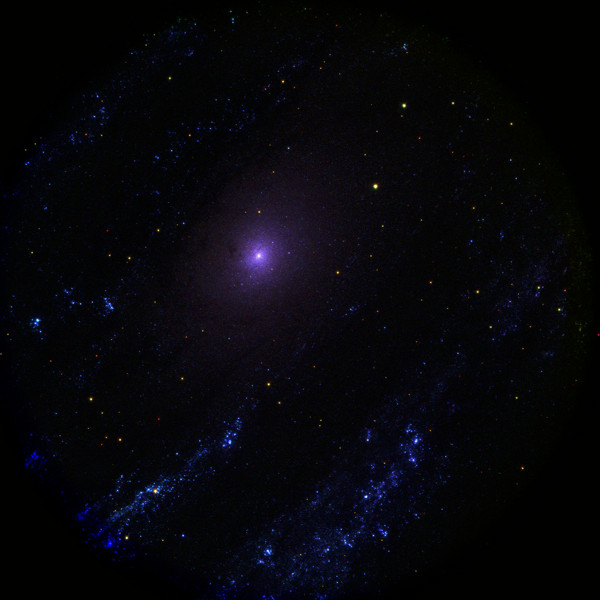The great Andromeda nebula, also know as M31 from the Messier catalogue, is the closest galaxy that is large and similar to the galaxy we live in - the Milky Way. Our galaxy and M31 are twin large spiral galaxies in the 'local group' of galaxies, that includes several dozen smaller galaxies. Most galaxies in the universe live in groups or clusters, which may contain some hundreds of galaxies. Galaxies began forming in the early universe out of regions where matter was more concentrated, and the large-scale structure of the universe today reflects those initial irregularities of matter. The study of galaxies that lie in the same group tells us how the universe has evolved over time, and what will happen next. M31 offers us the best example to study how our own galaxy evolved, as it is close enough to see individual stars, and see how they form the spiral structure that is their characteristic.
M31 is faint but large - it covers more sky than the moon. Telescopes on the ground have studied its stars and dynamics in visible wavelengths, with resolution of about 1 arcsecond. That is about 60 times finer than the naked eye can see. To get to more detail requires telescopes in space, or complex optics on the ground that cover areas much smaller than M31. Of particular interest are observations in Ultraviolet wavelengths, as these reveal the hottest, most massive, and youngest stars, whereas visible light shows up only the older, redder stars. These hot stars are the most recently-formed, and also the oldest (white dwarf) stars that are cooling after they have ended their lives. Ultraviolet light is absorbed by our atmosphere, so the only way to observe them is from a telescope in space.
The UVIT telescopes on the Astrosat orbiting observatory are designed to perform this way. They can see only the ultraviolet light, and can produce images with the same (1 arcsecond) resolution as large ground-based telescopes. With their wide field of view (the size of the moon), UVIT can map large objects such as M31 in a few pointings, and provide views that match the ground-based in a scientifically compatible way. No other orbiting telescope can do this. The Ultraviolet mages provide a dramatically different view of M31 from that we see from the ground.

The UVIT images allow us to make accurate measurements of thousands of stars, and match them to the visible data from the ground. These studies enable scientists to estimate how old the stars are, and to understand the processes of stars forming and dying. The measurements made over the range of Ultraviolet wavelengths that UVIT provides, also reveal the nature and composition of the interstellar dust in M31, which also reveals its different history compared with the Milky Way.
M31 and our galaxy are approaching each other at several hundred kilometres per second. In a few billion years, the two giant galaxies will merge into one - an event that will change their nature and star-formation forever. The sky will look very different when that happens.
Full resolution image [1.5MB]
Credits: UVIT Team/ISRO/CSA




